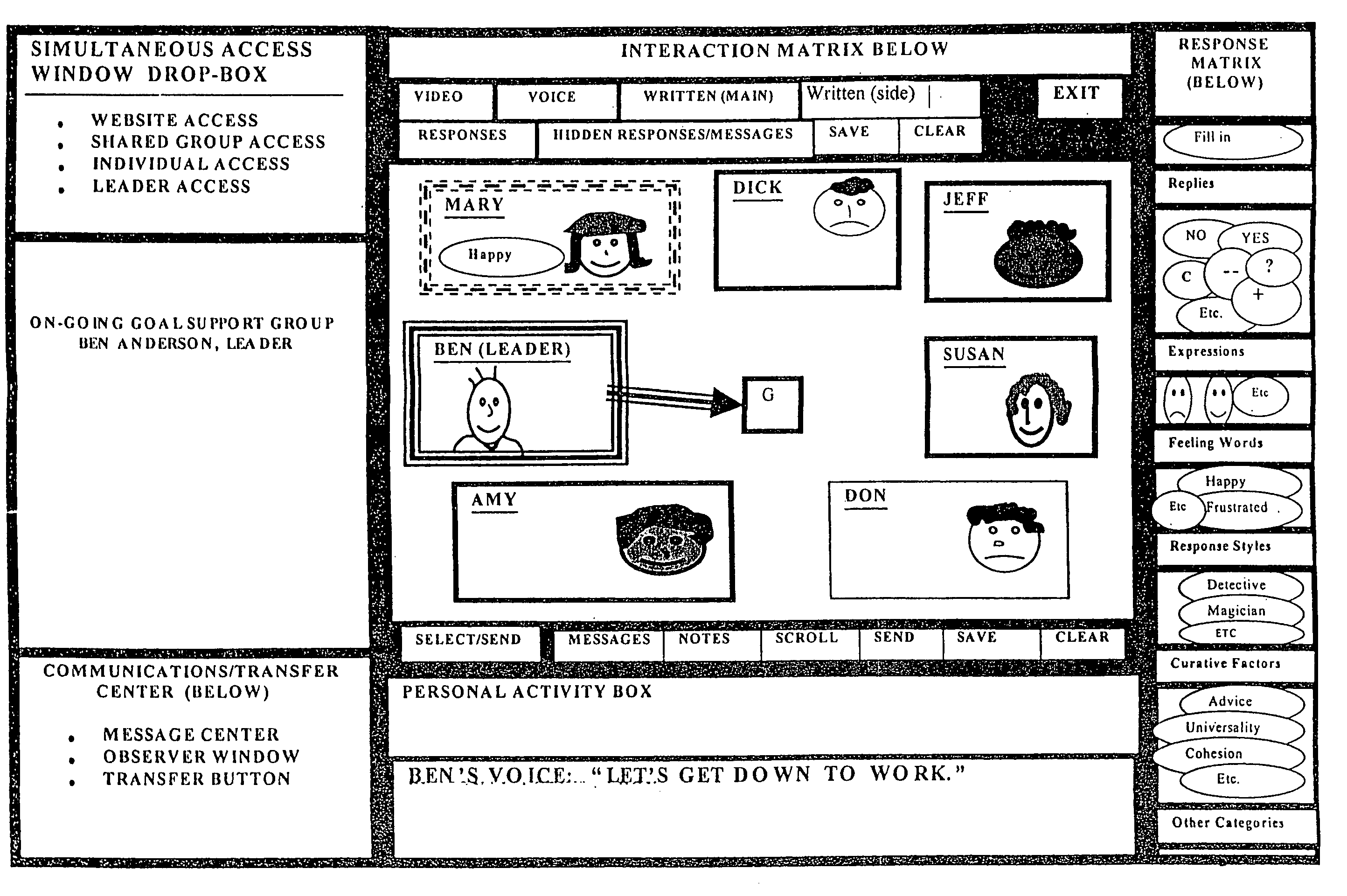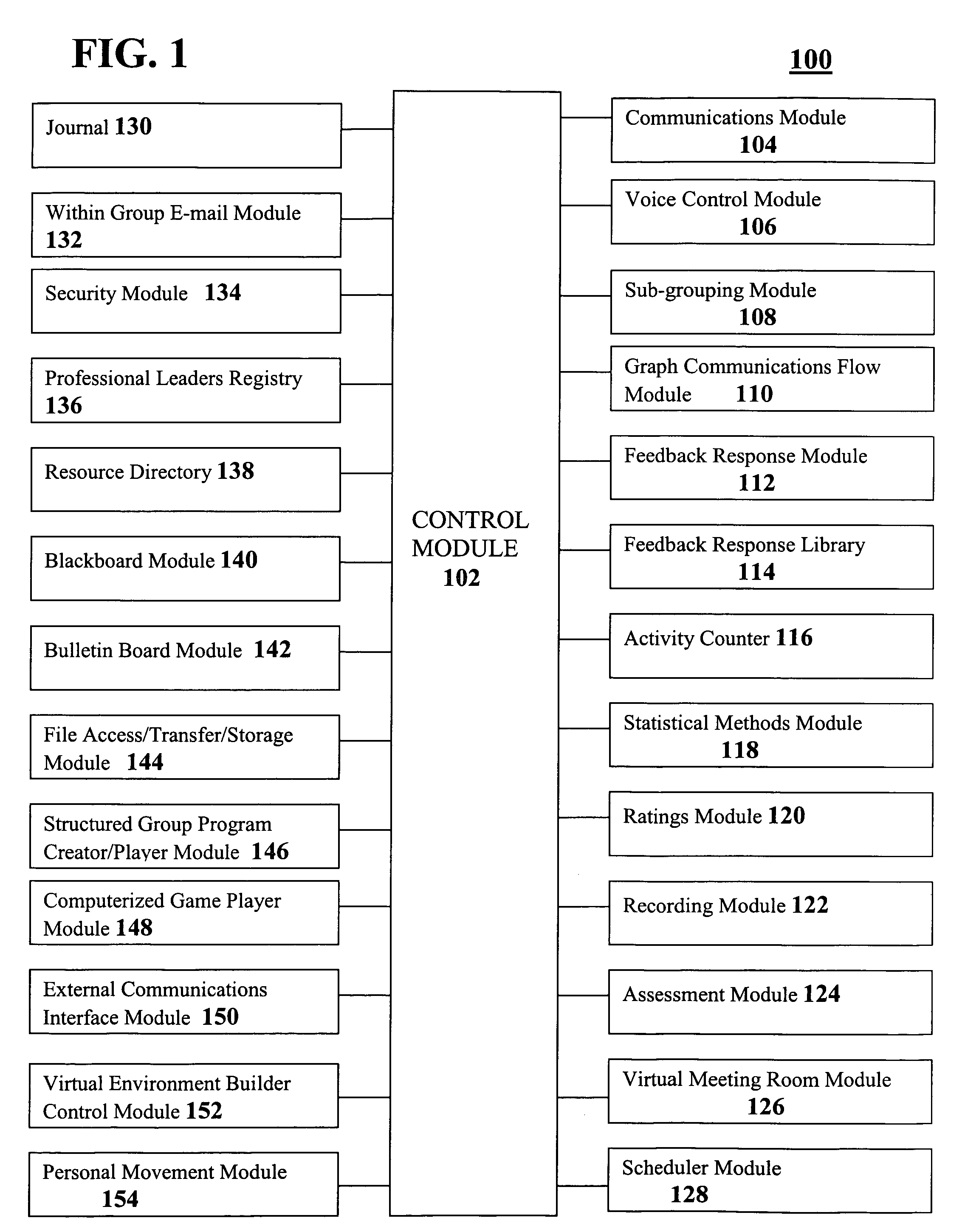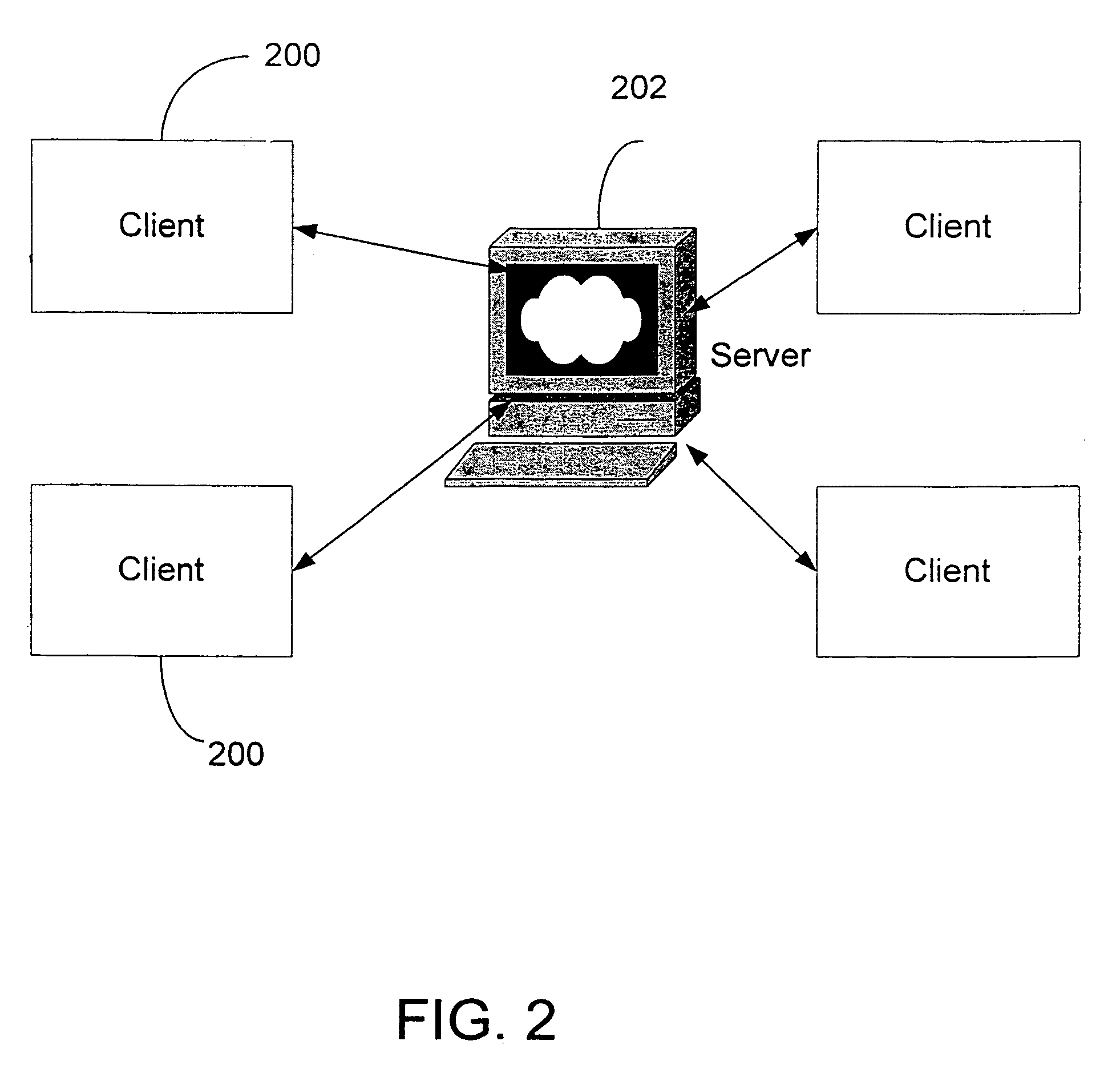There are many problems associated with currently available systems of computerized group interaction.
Generally speaking, conventional systems for virtual group interaction (e.g. chat-rooms) are poor replicas of actual communication in the real world.
They are even poorer imitations of the operation of real-life task-oriented work groups.
One major problem with currently available systems of group interaction is that they do not provide a way of visualizing all members of the group with whom one is interacting (including all verbal and nonverbal communications between members) as they are occurring simultaneously in real-time.
In existing systems of computerized group interaction (like chat-rooms and
virtual office meeting rooms), it is difficult to ascertain these things because a great deal of what is going on in the meeting (like simultaneous group activities and nonverbal communication) cannot be conveyed.
Another problem with these computerized systems is that communication must usually occur in a serial manner, one entry or message at a time, even though this is not the way natural communication in the real world occurs.
In existing systems of computerized group interaction, different types of simultaneous communication (like voice, text and iconic displays) between members of a group are not possible.
In addition, there is no way for participants in a group to choose to engage in different types of communication (like speaking, whispering, or sending a written note) nor to indicate the intended
receiver or target of each chosen communication.
Finally, there is no way for these “communication flows” (including the type of communication, the content of the communication, and the originators and intended targets of each communication) to be displayed so that all members of the virtual group can “see” what is going on.
Another problem with existing computerized systems is that some specially developed clinical methods for teaching group
communication skills cannot be utilized during the course of the meeting.
Despite the effectiveness of various types of exercises as aids to improving group skills, existing computerized discussion groups are currently unable to employ these methods.
However, there is no currently available system of group interaction that allows for obtaining these types of ratings, retrieving
activity level data, and or giving and receiving nonverbal feedback in ongoing groups meeting over global communication networks.
Another serious problem with existing systems of computerized group interaction is that they do not generally allow for the intended target or recipient of each communication to be represented to the participants in the group.
In real-life groups it is usually clear to whom a speaker is directing his / her comments or attentions, but in computerized group interaction it can be difficult to follow the group discussion because information about the target of communications is usually not readily available.
Because existing systems of computerized group interaction do not
encode information about both the originator and recipient (or target) or each communication, they cannot provide data about actor, partner and relationship effects in the Social Relations Model for feedback, training or research purposes.
Another problem with existing systems of computerized group interaction is that it is not possible for a large group of people to break up into smaller groups or dyads with the potential to be called back by an announcement to rejoin the larger group again.
The Kato system is limited in its ability to deliver a real-life social interaction experience over computer networks because participants can only engage in one type of communication at a time (voice, text or game interaction).
In addition, there is no way in the Kato system for participants to identify the target or intended
receiver of each message or communication.
Because participants in the Kato system cannot engage in different types of simultaneous communication, it is impossible for them to provide the different types of feedback described above.
Neither is it possible to obtain information related to the Social Relations Model, since the Kato system does not
encode both the originator and target of each communication exchanged.
And finally, there is no way in the Kato system for participants in a larger group gathering to break up into smaller groups or dyads with the potential of rejoining the larger group when desired.
The major problem with currently available computerized systems of group interaction is that they do not provide the capacity to engage in a group activity (e.g. view presentation materials together) while at the same time observing the participants interacting in the ongoing group.
This is a problem because most real-life work groups, academic groups, and support groups have content materials that are presented and discussed during meetings of the group.
Another problem with these systems is that they make no provision for taking notes or “minutes” while participating in the meeting.
This is a serious limitation, as in real-life meetings someone is usually asked to take notes during meetings and then is required to type them out for later
dissemination or
record keeping.
Another problem is that current systems do not provide a satisfactory method for creating and delivering structured group programs over computer networks.
There are no existing systems of computerized group interaction that provide a means to engage in all of these processes for working through a structured group program over computer networks.
The above-described limitations of existing systems of computerized group interaction combined with group activities are clearly evident in the patents cited during the examination of the present
patent application.
However, users are not able to send emails while they are at the same time participating in an ongoing discussion and viewing presentation materials together.
There are many limitations associated with the kinds of groups that are offered to the general public both in the “real world” and on
the Internet.
One main limitation is that there is no group program, either in the real world or on
the Internet, that is focused specifically on helping the general
population get support for reaching their personal goals.
But many people are averse to participating in those types of groups because of the stigma attached or because they feel they do not “fit” into that type of group.
Still others do not have the finances to go to professional group therapy sessions, nor the time or the transportation to
commit to
community support groups.
Some people may not know what they want to accomplish; others may want to accomplish unrealistic feats.
Some people may not know how to go about attaining their goals, while others know exactly what they need to do, but cannot bring themselves to take action.
Still other people have a
solid understanding of what they would like to accomplish, but are unable to locate the resources needed to actualize their goals.
But there is currently no place where people can meet together to get and give the support that is needed to help each other reach their personal goals.
But they do not allow participants to continue talking while playing the game as people do in “real-life” game playing situations.
The greater frequency of meetings involving more and more people has led to higher travel and office space costs (to allow for conference rooms), as well as decreased productivity of some workers.
While there are sites for groups to meet over
the Internet (e.g., e-groups.com and
voice chat systems), these sites suffer from many of the limitations of computerized group
interaction systems outlined in previous sections.
Specifically, these systems do not allow users to “see” the participants with whom they are interacting or to share on-line program materials with them.
While some team-ware and
virtual office systems are available for use over computerized networks, these systems also suffer from many of the limitations of computerized group interaction outlined above.
Other problems with existing computerized
virtual office systems include the following.
Currently available systems of electronic group interaction do not allow people outside of the participants interacting in a virtual room to observe the meeting.
Another problem is that it is not possible to reserve a meeting room for on-going work on a large project that requires intermittent attention from different participants over an extended period of time.
Another problem with currently available systems is that they do not allow for a new person to join a closed membership meeting that is already in progress (at the discretion of the “gatekeeper”) as often happens in real-life situations.
Nor do these systems allow people to move around the virtual environment or to choose which equipment they want to have in different virtual meeting rooms.
A final problem with currently available virtual
office systems is that the external sources of communication (including telephone,
intercom, office “door”, and email access) are not integrated with the ongoing interaction and activity of the group.
But the Kato system is very limited in the kinds of environments it provides (e.g., there is no choice of different types of equipment such as video projectors, karaoke machines, chalkboards, etc.).
 Login to View More
Login to View More  Login to View More
Login to View More 


